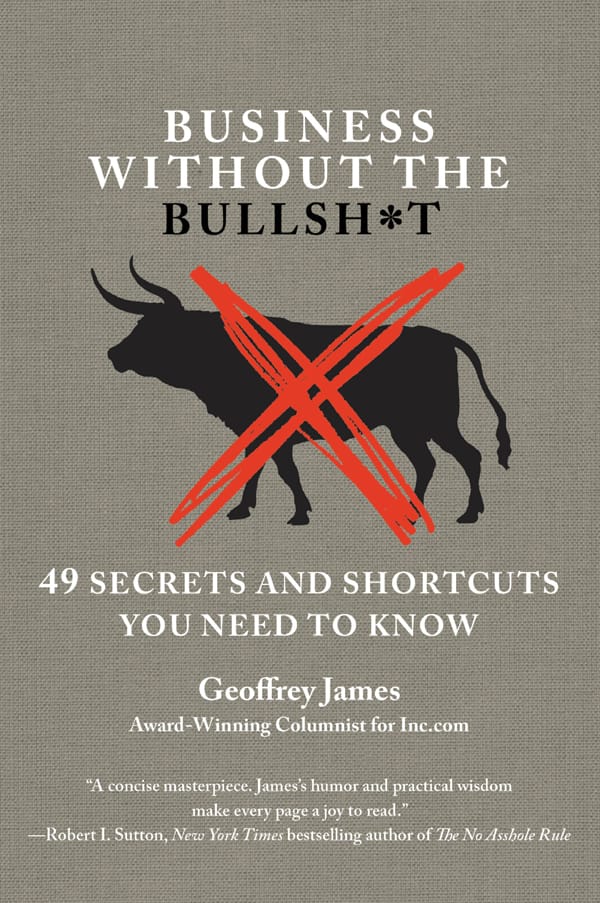Business Without the Bullsh*t by Geoffrey James

Main Themes:
This book is a practical guide to navigating the modern business world, cutting through the nonsense and achieving success. It focuses on actionable tactics and techniques for managing various situations, from dealing with difficult bosses and colleagues to giving memorable presentations and negotiating effectively. The overarching themes include:
- Pragmatism: The book emphasizes practical advice and real-world strategies over theoretical concepts.
- Direct Communication: Clear and concise communication is highlighted as essential for effectiveness and avoiding misunderstandings.
- Building Relationships: The importance of understanding and managing relationships with bosses, colleagues, and clients is stressed.
- Personal Effectiveness: Techniques for personal productivity, managing stress, overcoming fear, and handling rejection are explored.
- Navigating Office Politics: Strategies for identifying and dealing with manipulative tactics and political manoeuvring are discussed.
Most Important Ideas/Facts:
Part I: How to Manage Your Boss
- Twelve Types of Bosses: Understanding your boss's personality type is crucial for effective management. The book identifies 12 types, including the Dictator, the Waffler, and the Conqueror, each with their advantages and drawbacks.
- "Why should your boss bother to stab you in the back when it’s more convenient to stab you in the front?" - on the advantages of working with a Dictator.
- Keeping Your Boss Happy: Tailoring your communication to their preferred style, providing regular updates, and anticipating their needs are key to a good working relationship.
- Getting the Best from Your Boss: Frame requests in terms of benefits to the company, write the first draft of your performance review, and don't be afraid to ask for clarification on vague promises.
- Handling Unreasonable Requests: Force a discussion of priorities, don't make excuses, and if necessary, say no directly with a clear rationale.
- "If I do A thoroughly, I won’t be able to do B thoroughly. Which of the two is the real priority?" - a suggested response to an unreasonable request.
Part II: How to Manage Your Co-workers
- Earning Respect: Be genuine, show interest in others, share credit, dress appropriately, and think before you speak.
- "BE yourself rather than your role." - key to earning respect.
- Ten Types of Annoying Co-workers: From Wafflers to Geniuses, the book identifies various challenging co-worker personalities and offers strategies for dealing with each.
- "Wafflers can’t decide so force the issue." - concise advice on managing indecisive colleagues.
- Building Relationships with Mentors: Seek advice rather than requesting mentorship directly. Relationships develop organically over time.
Part III: How to Manage Your Career
- Landing a Job Interview: Customize your resume and cover letter to target the specific job description, focusing on the value you can offer the company.
- Acing the Job Interview: Research the company thoroughly, prepare insightful questions, rehearse answers to common questions, dress appropriately, and arrive early.
- Making Failure Impossible: Set achievable yet inspirational goals, write them down, commit to achieving them, set measurable milestones, monitor progress, welcome setbacks, and redefine failure as "failing to take action."
- "THE only true failure is failing to take action." - a powerful redefinition of failure.
- Becoming More Optimistic: Begin each day with expectation, look for the good in others, avoid negative conversations, celebrate successes, focus on solutions, express gratitude, and focus on the future.
Part IV: How to Communicate Effectively
- Avoiding Biz-Blabbing: Use simple language, replace jargon with common terms, and avoid clichés to ensure clear and effective communication.
- Having Meaningful Conversations: Know the reason for the conversation, ignore your "monkey mind" (internal distractions), acknowledge what was said, rephrase if necessary, and respond appropriately.
- Writing a Compelling E-mail: State the desired decision upfront, structure arguments into digestible chunks, provide evidence, repeat the conclusion as an action item, and include a benefit in the subject line.
Part V: How to Work a Room
- Networking Effectively: Position yourself strategically, introduce yourself in terms of the value you provide, differentiate yourself from the competition, observe interest levels, and open a conversation to assess mutual needs.
Part VI: How to Negotiate
- Negotiating an Agreement: Define the parameters (what's negotiable and what's not), know your best and worst-case scenarios, listen carefully, avoid emotional reactions, turn positions into problems, and be willing to walk away.
Part VII: How to Cope with Evil
- Identifying Dirty Politics: Be wary of development opportunities that seem too good to be true, rock fetches (impossible tasks designed to delay decisions), and situations where you're being set up as a scapegoat.
- "DEVELOPMENT OPPORTUNITIES: Avoid them because you’re about to be used." - succinct advice on navigating office politics.
- Spotting Workplace Lies: Be aware of verbal and written cues, be wary of overly insistent claims of truthfulness, and learn to flush out half-truths and indirect lies.
Overall:
"Business Without the Bullsh*t" offers a wealth of practical advice for anyone seeking to thrive in the modern business world. By focusing on clear communication, strong relationships, and effective personal strategies, the book provides a roadmap to achieving success while avoiding unnecessary drama and manipulation.
Click here to purchase on Amazon today!
